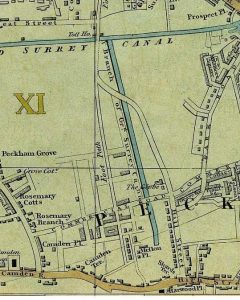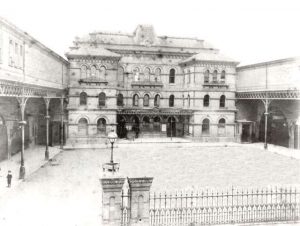Early public transport
In 1744 a coach was advertised to leave the “Cross Keys and Spread Eagle,” Grasschurch Street, “every day” to Peckham, but as no times of starting were specified, we are unable to state whether the coach made one or more journeys daily. That the number of journeys made every day must have been limited, is evident from the fact that in 1796 the Camberwell coach was advertised to leave the “George and Gate” during the summer only, and that up to 1 p.m. only one journey had been made.
The Camberwell West-End coach was advertised in the same year to leave the “Anchor and Vine,” Charing Cross, daily at 11.30 a.m. and 7.30 p.m., and another left the “Kings and Keys,” Fleet Street, daily at 12 noon and 3 and 8 p.m.
The Peckham coach started from the ” George and Gate,” Gracechurch Street, daily at 11 a.m. and 1, 4, and 7 p.m. From the ” Kings and Keys,” Fleet Street, daily at 12 noon, and 1, 3, and 8 p.m., and the “Red Lion” Alehouse, Strand, daily at 11 a.m. and 7 p.m., and the “Horseshoe and Magpie,” Bridge Street, Westminster, daily at 11 a.m. and 7 p.m.
The Dulwich coach left the “Pewter Platter,” Gracechurch Street, daily at 11 A.M. and 6 p.m. in summer, and at 5 p.m. only during winter.
The length of time occupied by these coaches in their journeys to and fro was no doubt attributable in the main to the wretched state of the roads, and to the fact that, instead of proceeding direct on their journey, the coach was driven to the houses of the fortunate passengers who had been successful in booking a place. To the heavy state of the roads must also be attributed another cause of delay, as it was almost a matter of necessity to bait the horses once or twice on the journey. The Peckham coach invariably made a halt at the “Red Cap,” Camberwell Green, and to be detained for twenty minutes at that well-known hostelry was an everyday occurrence.
Ye Parish of Camerwell W.H. Blanch (1875)

Grand Surrey Canal in about 1850
The Grand Surrey Canal
The Grand Surrey Canal was opened in 1807. Originally called the Kent and Surrey Canal, it was built primarily to transport timber and ran between the Old Kent Road and Surrey Docks at Rotherhithe Old Kent Road. A spur was extended south to Peckham in 1826.
The timber trade to the docks ceased by the early 1970s and the canal was then simply filled in during 1972.
For more information see:
https://londoncanals.uk/tag/peckham
https://greatwen.com/2016/03/24/secret-london-south-londons-lost-canals
Thomas Tilling and the omnibus
Thomas Tilling (1825-1893) started business in 1845 in Walworth with one horse. In January 1850 he moved to Peckham and bought a horse bus with the right to run four journeys a day between Peckham and Oxford Street. He called it the “Times” – and ensured that it ran on time from pre-arranged stops rather than delivering passengers to their homes. The business flourished: by 1856 he owned 70 horses, and in the early 1870s claimed to have nearly 700 with offices at Winchester House in the High Street. In 1866 Tilling was contracted to supply and train horses for the newly-formed Metropolitan Fire Brigade.
Tilling passed the business on to his sons, Richard and Edward. In 1908 Thomas Tilling Limited introduced the first petrol-electric bus in London in 1908, and as the 20th progressed the company became one of the largest transport organisations in the country with interests in almost all of the major bus operating companies.
For more information see:
http://www.petergould.co.uk/local_transport_history/pioneers/people/tilling.htm
http://peckhampeculiar.tumblr.com/post/123265231549/all-aboard
Railways
The London, Chatham, and Dover Railway was created on 1 August 1859. It opened stations at: Peckham Rye (1 December 1865) and Nunhead (1 September 1871).
For more information on Nunhead Station: http://www.disused-stations.org.uk/n/nunhead/

Peckham Rye Station
The London, Brighton and South Coast Rail was created by a merger of five companies in 1846. On 13 August 1866 it opened stations on the South London Line at: Peckham Rye (shared with LC&DR), Old Kent Road (closed 1917) and Queens Road Peckham.
On 9 December 2012 the spur from the Old Kent Road Junction to the East London Line was re-instated as part of the London Overground system stopping at Peckham Rye and Queen’s Road stations.
Trams
Horse-drawn trams started in London in 1860 Following the 1870 Tramways Act one of the first four lines built ran from Blackheath to Vauxhall via Peckham and Camberwell. The line from Camberwell Green to Westminster was opened on 25 September 1871, and from New Cross to Camberwell Green along Queen’s Road and Peckham High Street on 28 January 1872.
By the turn of the century electric trams had been introduced. The National Steam Car Co. Ltd. built a garage in Nunhead Lane in 1911. The last London trams ran in July 1952.
[add_posts category=”transport” how=”99″ h=”6″ img=”true”]


